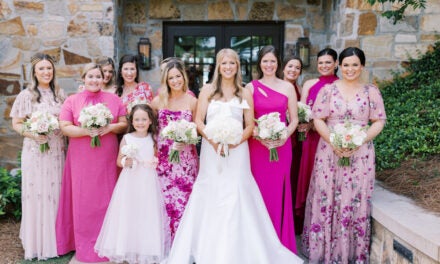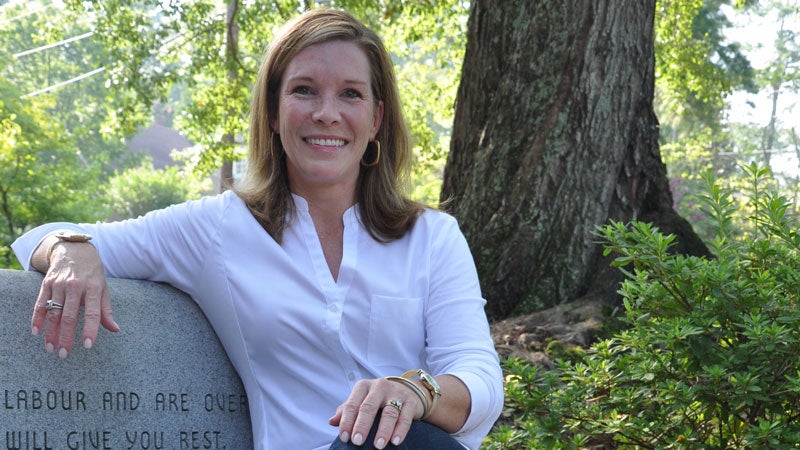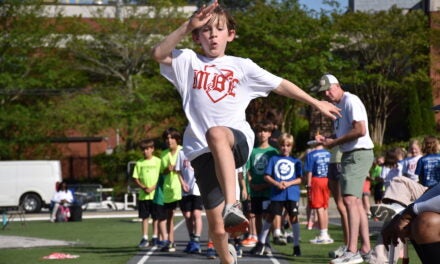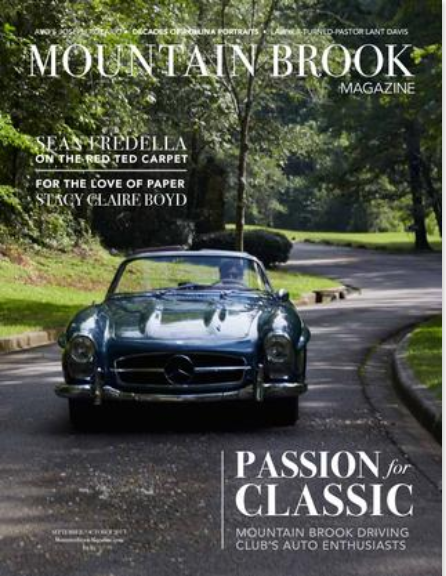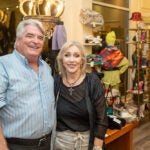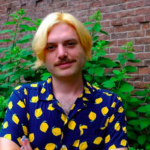A sense of peace exudes from 33 pastoral acres off Highway 119 in Leeds. It comes from the quiet on the tranquil fields and under its towering trees, but more than anything it comes from the 18 horses who call it home. Tusker, Dottie, Elvis and all the others are as majestic in stature as they are intuitive in their understanding of the children they work with.
It’s with the horses at The Red Barn that countless lives of children with disabilities have been transformed. Joy O’Neal, the organization’s executive director, tells the story of a young girl with autism whose family had lost her home in a tornado, and then not too long later she suffered yet another traumatic experience when her family’s apartment was invaded. It was at that point that the girl stopped speaking altogether.
“When she came in (to the barn) she didn’t like to look at you,” Joy recalls. “But when she got around the horse, she said, ‘Horse!’” Yes, that was her first time to speak since the home invasion. “The first time she told that horse to ‘walk on’ there wasn’t a dry eye around because she speaks so seldom,” Joy continues. “Her mom always says she talks more at the barn than anywhere else.”
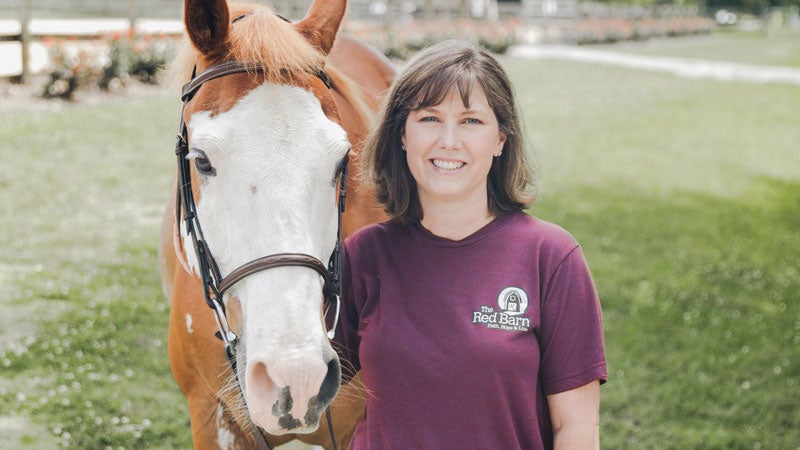
Joy O’Neal
The Vision
The backstory of The Red Barn started not with Joy but with a woman named Anita Cowart, whose daughter was killed in a car accident in the 1960s. Ms. Cowart’s friends, the Jernigans, owned farm property in Leeds at the time, and it’s there that she went to pray and seek solace following the tragedy. “And she remembered a (Bible) verse that said whatever pain that is used to glorify God is returned 100 times. She began to pray and said, ‘I want not just 100 more daughters but 1,000 if I can use my pain to glorify you.’”
And so one by one these “daughters” started coming to ride horses with Ms. Cowart out in Leeds just like her daughter had done, and then they’d bring their younger siblings and so on. In the 1990s Joy, her husband and the five kids that made up their newly blended family would come to Ms. Cowart’s farm, Heathermoor (named after the road that runs by Mountain Brook Elementary School), seeking an activity their family could enjoy together.
Later the O’Neals would buy a farm in Leeds of their own, and Heathermoor would move there. “Before she died in 2007 Ms. Cowart and I walked around the property and talked about all the kids who didn’t have an opportunity to ride horses and that we wanted to do it in the red barn on the property,” Joy recalls. And that wasn’t all. The O’Neals’ property was actually the same one the Jernigans’ owned in the 1960s where Anita had first prayed, and not long before her death a dream Mrs. Cowart had had prompted a more specific vision of a barn with kids in wheelchairs or who were sad or hurting who, after they went through the barn, came out happy and dancing and healed. “And that was all we wanted to do,” Joy says.
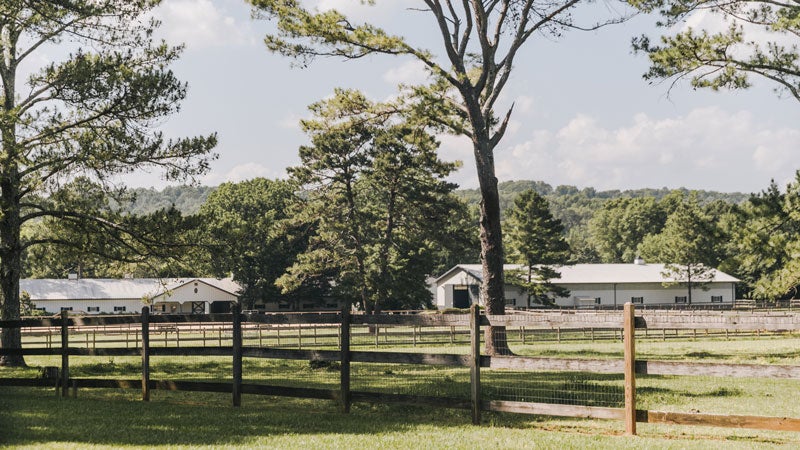 And so when Heathermoor moved back to its original property in 2009, Joy was left with an empty farm, Ms. Cowart’s vision and more time than she’d had in years as her teenage children no longer needed her as a room mom or to volunteer in elementary reading programs.
And so when Heathermoor moved back to its original property in 2009, Joy was left with an empty farm, Ms. Cowart’s vision and more time than she’d had in years as her teenage children no longer needed her as a room mom or to volunteer in elementary reading programs.
But being human, “the first thing I did was argue with God,” Joy recalls. “You don’t need me, I am not qualified, I am not the right person, I said. I tried to give (the property) to lots of other people and similar (equine therapy) organizations but I couldn’t get any takers.” However, she did take time to get a master’s degree in nonprofit administration, and by 2012 she was bringing Ms. Cowart’s vision to life.
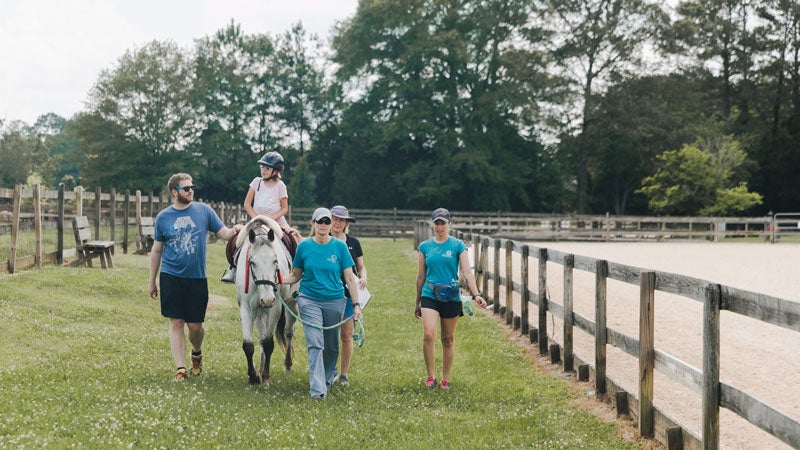 Originally the plan was to use the small red barn that would be the farm’s namesake for therapeutic programs and to run the larger barns as a for profit-business to fund the nonprofit side of the operation, but soon they realized there was such a demand that they needed to use all of the facility for therapeutic purposes.
Originally the plan was to use the small red barn that would be the farm’s namesake for therapeutic programs and to run the larger barns as a for profit-business to fund the nonprofit side of the operation, but soon they realized there was such a demand that they needed to use all of the facility for therapeutic purposes.
In short, “we provide a place where kids can come be kids and work with horses and learn from them,” Joy explains. That can look like horseback riding lessons, occupational therapy, job skills training or educational classes that help kids learn experientially. Today around 100 kids a week visit the barn, and 11 full-time and eight part-time therapists, riding instructors and more work with those kids seven days a week. The barn’s typical student is a child who cannot ride horses elsewhere because of a disability or circumstance. Most come from a low-income background and receive a full scholarship for the program.
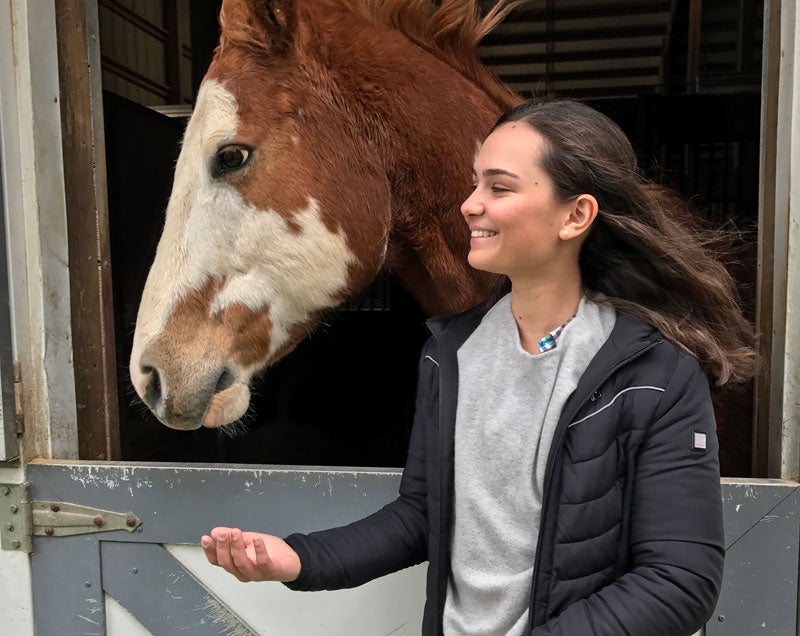
Salter Hydinger
Stories Transformed
More than The Red Barn is a list of numbers and programs, it’s a place that transforms story after story. Each semester for the past two years, rising high school senior Salter Hydinger has volunteered with riding lessons at the barn, working with different students each semester, one autistic, one who had been abused, two with traumatic brain injuries—and all who she says have taught her new things.
She recalls how one girl who had been abused wouldn’t look her in the eye when they started riding lessons, and 18 weeks later, she was asking how Salter’s day was and giving her hugs. “That’s really amazing,” Salter says. “The horse is a trust symbol for them. A lot of kids have verbal difficulties, so often they can talk to the horse since the horse can’t talk back.”
And with the older kids, Salter can talk to them about her experience with horses too since she started riding at age 6 and now travels with her horse Anthem to compete nationally everywhere from Florida to Michigan. As someone who knows horses quite well herself, she’s quick to credit them. “These horses truly are called to do this work,” she says of The Red Barn horses. “They are sweet and gentle and know how to take care of these kids. That’s really special to watch.”
It’s not just about the horses either. For those who come to The Red Barn, they have a sense of belonging with their “barn family” too. These kids are who they are, and it doesn’t matter if they have tics or look different. At the barn parents can talk to other parents whose children have a similar diagnosis too.
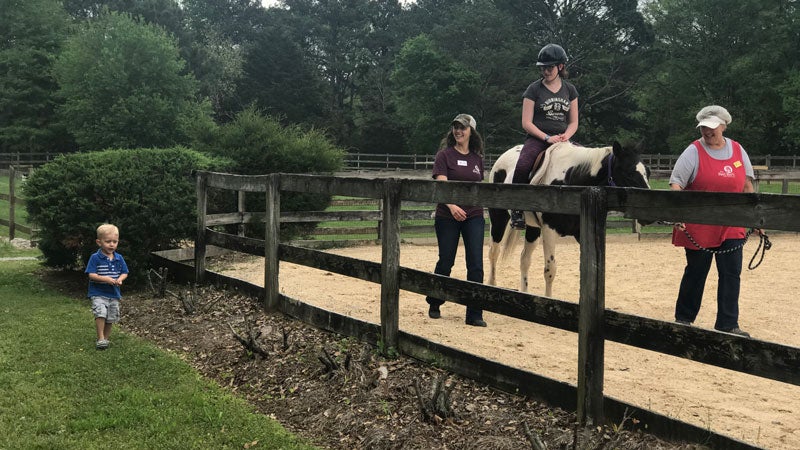 If you know 16-year-old Erin McInerny, she’s probably told you how awesome The Red Barn is and how she loves everyone there. “The Red Barn is a place where she is accepted for who she is and where she sees other people be successful who are like her, and that’s a really important component when you have autism,” her stepmom Jenny says. “It provides her with an extracurricular she can feel good about, and it’s a safe place where she can feel accepted.”
If you know 16-year-old Erin McInerny, she’s probably told you how awesome The Red Barn is and how she loves everyone there. “The Red Barn is a place where she is accepted for who she is and where she sees other people be successful who are like her, and that’s a really important component when you have autism,” her stepmom Jenny says. “It provides her with an extracurricular she can feel good about, and it’s a safe place where she can feel accepted.”
And like countless others, it’s been a place where Erin has been transformed. “She has matured over the past four years in her self-awareness and mood regulation,” Jenny explains. “Sometimes she makes huge leaps and bounds, and then we fall backwards. It’s cyclical.” Erin hasn’t just participated in lessons either, as she’s also participated in grief programs and job skills training.
In job skills training, participants learn ways to be responsible, problem solve and complete tasks in the correct order. They’re washing buckets, dusting, cleaning, doing laundry and filling water troughs, but along the way they are also honing skills that will help them in a job one day. “There has to be a lot of explanation behind learning how to work in a job environment and understanding the small things a typical employer wouldn’t think to understand,” Jenny says. “(Now Erin) takes more pride in her chores at home, and we get feedback from the instructors so we can apply what she is learning to the home setting and use the same language and reinforce the things that are being taught (in the barn).”
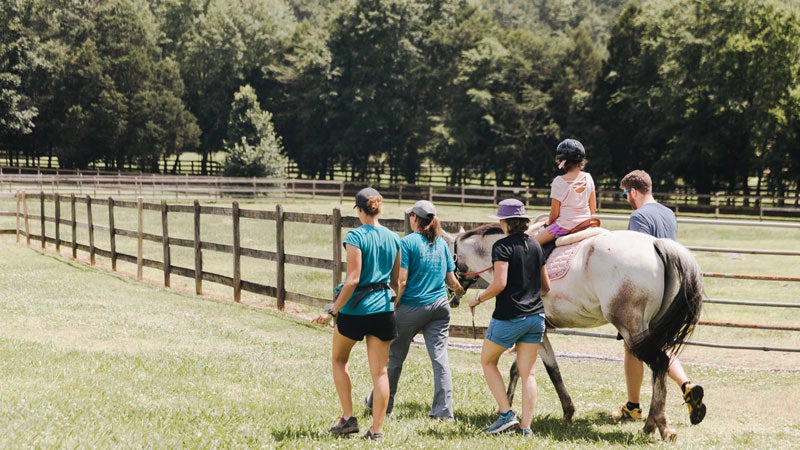 A Place of Healing
A Place of Healing
Take a tour of The Red Barn’s properties, and you might be surprised at not just how tidy the facility is but also all the therapy tools they use. In the upper barn you’ll find Beatrice, Harry, Troy, Helen and Elijah—all “phony ponies” or faux horses of varying sizes designed for therapeutic purposes that build stamina for kids and help them get used to the idea of a riding a live horse. Down at the lower barn, though, you’ll find around 18 live horses, brown, black or spotted, who love their jobs just as much as the barn’s human staff.
Everywhere you look on the property is therapeutic in some form or another. For kids with physical disabilities, the movement of the horse under the rider mimics human pelvic movement, and those who struggle to walk are able to strengthen their legs as they steer a horse. It’s not uncommon for children to come to the barn barely able to walk and later to run so fast the adults can’t catch them.
In the occupational therapy realm, grooming a horse and holding the reins teach fine motor skills that are transferrable to kids’ everyday lives. The barn also works with veterans who bring their injuries and anxieties along with their families to the barn to find a peaceful place to connect with horses.
Like any living being, sometimes the horses’ lives come to an end at the barn, which a teaching moment for the participants in their programs. “We want to offer them the opportunity to experience grief in a safe way that allows them to ask questions because we will all experience a death or a loss in our lives,” Joy says. And so they bury the horses on the property and allow the kids to write notes and ask questions, especially as it often brings up their own memories of relatives or friends who have died.
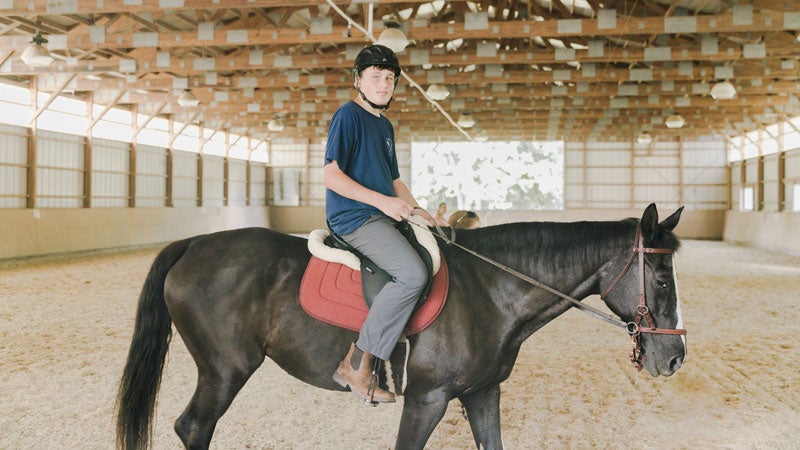 Today Joy can tell you endless stories of the kids who have been to The Red Barn. When she’s in Crestline Village often she’ll see children who she remembers struggling to follow basic directions or walk from their car to the barn alone now walking home from school and chatting with other kids. For Joy there’s much joy in seeing stories like those play out with the horses she spends her days with.
Today Joy can tell you endless stories of the kids who have been to The Red Barn. When she’s in Crestline Village often she’ll see children who she remembers struggling to follow basic directions or walk from their car to the barn alone now walking home from school and chatting with other kids. For Joy there’s much joy in seeing stories like those play out with the horses she spends her days with.
In 2017, though, the barn story became more of her own when her first grandchild was born with spina bifida. And that, she said, shifted her perspective. “Now my own granddaughter can come here and receive the exact same services as a child (we serve), and that’s amazing,” she says. “It was after she began riding (our horses) that she began crawling, and now she’s walking on a walker.” Perhaps her face is one of the ones Ms. Cowart saw all those years ago, transformed through a barn, The Red Barn.
Support The Red Barn
Give
The Barn welcomes cash, stock or in-kind donations and has forms setup on theredbarn.org to do so.
Volunteer
No horse experience is necessary, and volunteers are needed for riding lessons, camps, chores, supply drives and more. Find more information on theredbarn.org.



